return to itm online
HAWTHORN (CRATAEGUS)
FOOD AND MEDICINE IN CHINA
by Subhuti Dharmananda, Ph.D., Director, Institute for Traditional Medicine, Portland, Oregon
Crataegus, commonly called hawthorn, is a well-known herb in traditional Chinese medicine and is an herb remedy in cultures throughout much of the world where there is a temperate climate supporting growth of the trees, especially in Europe. The species used in China, Crataegus pinnatifida, differs from that which is relied upon as a source of the Western herb, obtained mainly from Crataegus monogyna and Crataegus oxycantha. Western herbalists primarily use hawthorn for treatment of heart disease; this application has been adopted by Chinese herbalists as well. In ancient times, the Chinese herbalists mainly used crataegus (shanzha) to improve digestion; for the past thirty years, Western applications of crataegus have been verified by Chinese researchers and added to its list of applications in Chinese medicine. Numerous Chinese formulations now incorporate the herb for strengthening heart function, lowering blood lipids, and dilating blood vessels to promote blood circulation.
| 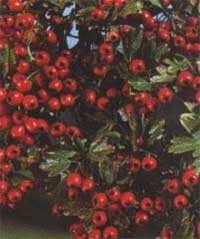
|
The fruit is the main part of the crataegus plant used in Chinese medicine. The fruit is sold whole (processed with sugar) and has also been made into several popular food products in the form of sugared strips that are eaten as a confection. Crataegus juice has also been manufactured into fruit drinks and soft drinks (see appendix) and into a vinegar product.
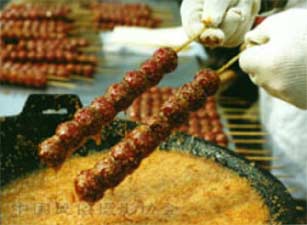
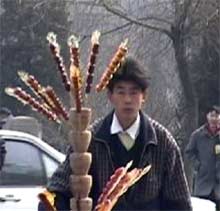
| 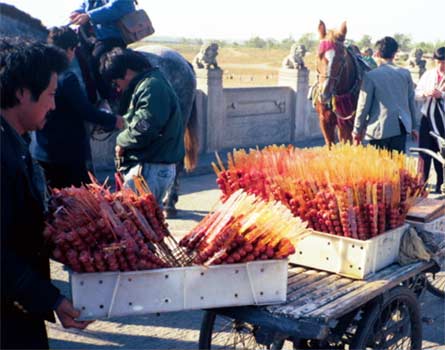
|
Upper left: Hawthorn fruits are dipped in boiling sugar water to make a candied snack.
Lower left: Hawthorn seller with spears of fruits.
Right: Distributor of hawthorn fruit spears to street sellers.
|
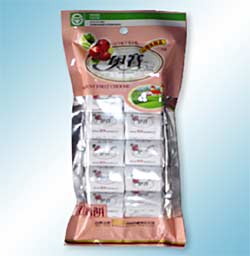 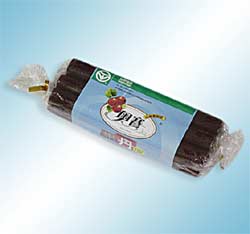
Left: bags of pressed hawthorn-sugar in thin blocks;
Right: bags of rolled hawthorn-sugar in the same form as common "fruit roll-ups" sold in the West.
These are from Shandong Province.
|
TRADITIONAL USE AS DIGESTIVE AID
Among the traditional Chinese herb formulas that include crataegus, the majority are digestive aids. The commonly used formula with crataegus as the dominant ingredient is Baohe Wan, first recorded in the book Danxi Xinfa (Essence of Teachings by Zhu Danxi; 1481). The formula is (1):
| Crataegus
| 180 g
|
| Shen-chu
| 60 g
|
| Pinellia
| 90 g
|
| Hoelen
| 90 g
|
| Citrus
| 30 g
|
| Forsythia
| 30 g
|
| Raphanus
| 30 g
|
The herbs are ground to powder and made into pills with water; the dosage is 6-9 grams each time, and this is best taken with a decoction of germinated barley (malt: maiya; which is sometimes simply listed as an ingredient of the formula). The formula was developed for treatment of abdominal fullness due to "food retention," a situation where the food that has been consumed is not digesting well. As a result of this indigestion, one feels no further appetite, and may have belching, acid regurgitation, and/or diarrhea; there will often be pressure felt in the lower intestine. While originally used for persistent digestive problems, the formula is often used today simply to relieve fullness that follows overeating or consumption of a meal that is difficult to digest. A slightly modified version is the Great Tranquility Pill (Da An Wan), which adds white atractylodes to the formulation. And, a much simplified version of Bao He Wan was also developed, called Major Crataegus Pill (Da Shanzha Wan), consisting of just three ingredients: crataegus (77%), shen-chu (11.5%), and malt (11.5%). The indications are the same as for Bao He Wan. Although these variants are far less commonly used than Bao He Wan, the focus on crataegus in these formulas (35% of Bao He Wan and 32% of Da An Wan) indicates that it is likely the primary active component.
The reputation of crataegus is that it promotes the digestion of meat and fatty foods. The presumed mechanism of action is to stimulate the production or activities of enzymes (such as proteases and lipases) that digest these food substances and/or stimulate production of bile, which especially assists the digestion of fats. The fruit contains small amounts of lipase and one of the fruit constituents, crataegolic acid, is reported to increase the activity of proteolytic enzymes. However, it is unclear whether there is sufficient content of these compounds to significantly enhance digestion of fats and proteins and the mechanism of action may rely on other active ingredients.
CRATAEGUS FOR CARDIAC DISEASE
In Western herbalism, crataegus fruit, leaf, and flower have all had a long history of use for treating cardiac weakness, and this has become a focus on modern research efforts (2). Controlled clinical trials are in the early stages, but evidence to date indicates that crataegus is an aid to persons with chronic heart failure. It appears to improve the left ventricular function and, as a result, improve exercise capacity and tolerance (3). In addition, crataegus provides many of the benefits attributed to Chinese herbs that are "blood vitalizers:" reducing blood lipids, improving blood circulation, and alleviating hypertension (via vasodilation). These effects may be attributed primarily to the flavonoids of crataegus.
An overview of the active constituents reveals these main groups:
Flavonoids: hyperoside, luteolin-7-glucoside, rutin, quercetin, vitexin, and vitexin rhamnosides
Oligomeric procyanidins and flavans: catechin and epicatechin polymers
Triterpene derivatives: oleanolic acid and ursolic acid
Organic acids: citric acid, tartaric acid, ascorbic acid
Simple phenolics: chlorogenic acid and caffeic acid
Each of these is present in relatively small amounts, with the flavonoids being dominant. Standardized extracts have been offered commercially, with only 2% hyperosides in leaf extract and 2-4% vitexins in fruit extract (the dried fruit is about 1% vitexins). The safety of the fruit is illustrated by its extensive use as a food in many areas of China.
An example of a modern blood-vitalizing formulation featuring hawthorn is the "Brain-Vitalizing Pill" (Nao De Sheng), which has the following constituents (1):
| Crataegus
| 60 g
|
| Carthamus
| 35 g
|
| Cnidium
| 30 g
|
| San-chi
| 30 g
|
| Pueraria
| 10 g
|
The herbs are ground to powder, and made into pills with honey; the dosage of the herb powder to be taken each time is about 6.6 grams. It is intended to dilate the blood vessels, improve blood circulation, and reduce blood lipids. It is mainly used for coronary heart disease, atherosclerosis, and post-stroke syndrome (CAUTION: this formulation could interact with blood thinners such as Warfarin, to decrease platelet action). Another fruit, hippophae (shaji), has been developed into a similar cardiovascular therapy, and it also contains flavonoids as active components. Some modern herb products combine crataegus and hippophae to promote cardiovascular health.
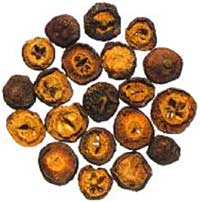
Dried crataegus slices as they appear in Chinese pharmacies.
REFERENCES
- Huang Bingshan and Wang Yuxia, Thousand Formulas and Thousand Herbs of Traditional Chinese Medicine, vol. 2, 1993 Heilongjiang Education Press, Harbin.
- Blumenthal M, Goldberg A, and Brinckman J, Herbal Medicine, 2000 American Botanical Council, Austin TX.
- Degenring FH, et al., A randomized double-blind placebo controlled clinical trial of a standardized extract of fresh Crataegus berries in the treatment of patients with congestive heart failure NYHA II, Phytomedicine 2003; 10(5): 363-369.
January 2004
APPENDIX 1: Chengde Qingsongling Beverage Group Co.
The Chengde Qingsongling Beverage Group Company is located at the foot of the Wuling Mountain (2,114 meters, about 6,800 feet). It is the highest peak of the Yan Mountain range of the national natural protection area in Xinglong County of Chengde City, Hebei Province. It is the natural science and education base for the most extensive animal and plant resources in the whole region. Besides the thick forest resources, the Liuliping Forest Park at this site has many kinds of animals such as monkey, pheasant, antelope, and roe deer.
The Qingsongling Company is at the boundary of the former protected site that existed during the Qing Dynasty. The area-which is particularly rich in fruit trees-has been closed for many years and hunting is forbidden to preserve its natural resources. The fruit forest covers over 100 square miles in the surrounding area. The soil and climate are optimal for growing hawthorn. The production of hawthorn from this forest area ranks first place in China. Hawthorn fruit now has become the "red pearl" that people rush to purchase as a healthful snack. The Xinglong hawthorn has a good quality and taste that is desired across the country. It is characterized by fresh red color and big fruit, thick, soft and tenacious fruit meat, sweet and mildly sour taste. There are also more than 30 kinds of fruits growing in this area, such as wild pear, wild jujube, wild grapes, kiwi, Jingdong white pear, wild autumn pear, and Longfu apple. About 120,000 tons of fruit are collected annually from this forest region.
| 
|

| The Chengde Qingsongling Beverage Group Co. was established in 1981 (originally called the Joint Comprehensive Fruit Processing Plant), with fruit processing as its core business. Since its establishment, it has built up a fruit-based alcoholic drink production line with annual capacity of 1000 tons, which can produce both the fruit alcoholic drink and other non-alcoholic beverage drinks. One production line with annual capacity of 2,500 tons can produce varieties of fruit juice (including extracting juice by using the pressing method). Another production line with capacity of 2,500 tons produces Zhonghua Cola, hawthorn cola, hawthorn soft drink, and orange soft drink etc.. Another production line produces 800 tons of low-sugar candied fruit. One production line produces a liquid drink from the seed of hawthorn. The Qingsongling natural beverage products are sold in Beijing, Tianjin, Shanghai, and in Northeast China, and also distributed to foreign countries.
|
The company has close technical cooperation from some universities and institutes such as China Agriculture Engineering University, Food Ferment Research Institute (of the Ministry of Light Industry), China Modern Food & Health Research Co., and Guangzhou Food Industry Research Institute. The cold extraction method and low temperature extraction methods that are used to produce original hawthorn juice are new developments for China and the process was awarded a national patent. During the 25th Olympic Games in Barcelona in 1992, Qingsongling hawthorn nectar became the official beverage of the Chinese sport delegation. In 1993, it won the Brussels Ulica International special prize and in Bangkok it won the China High Quality Product and Science and Technology Achievement Gold Prize. In recent years, the company developed a series of other natural fruit juice products such as wild jujube juice, wild pear juice, apple juice, and apricot kernel juice. Other companies have followed in the footsteps of Qingsongling. For example, Hebei Mangyuan Food Co. Ltd was set up in 1988 to produce fruit beverages from the forest produce, including hawthorn wine, hawthorn tea, and hawthorn juice
.








